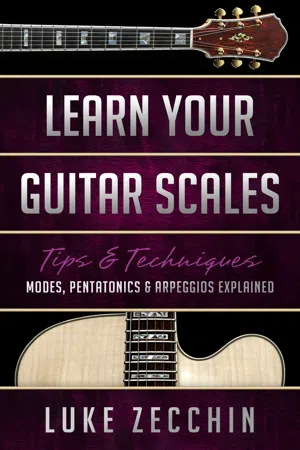

Learn Your Guitar Scales
Modes, Pentatonics & Arpeggios Explained (Book + Online Bonus)
- English
- ePUB (mobile friendly)
- Available on iOS & Android
About This Book
FINALLY, LEARN HOW IT ALL FITS TOGETHER
Confused about guitar scales? Knowing how to play scales and knowing how to use them are two different things. Seeing shapes outlined on the fretboard is useful, but it doesn't help us understand what to do with them! This is a common frustration with many scale books for guitar. What's the point of learning all this information if we're unable to make something musical out of it?
Learn Your Guitar Scales provides a comprehensive introduction to the fundamental patterns that underpin everything we do on guitar. Beyond simply demonstrating what these shapes look like, this book explores the sound, structure, and common uses of each pattern in context. This guide also offers various tips and exercises for applying this information practically. Insightful and easy to understand, this is a must-have handbook for any guitar player wanting to make sense of how it all fits together!
ONLINE BONUS: This book is complete with free online bonus material. It comes bundled with a companion website to enhance your learning experience. Extras include audio examples, backing tracks, bonus downloads, and more.
Join thousands of students worldwide! Like easy-to-follow lessons, pro playing tips, and jam-packed value? You'll love learning from this international bestselling instructor.
SCROLL UP AND BUY NOW TO GET STARTED
Frequently asked questions
Information
Chapter One
FOUNDATIONAL CONCEPTS

Why Scales?
Understanding Scales

Using Scales
Learning Scales
Table of contents
- Cover
- Title Page
- Copyright
- Dedication
- Fretboard Memorization Workshop
- Contents
- Preface
- Online Bonus Material
- Introduction
- 1. FOUNDATIONAL CONCEPTS
- Why Scales?
- Understanding Scales
- Using Scales
- Learning Scales
- 2. OCTAVE SHAPES
- Using Octave Shapes
- Octave Shapes
- 3. MODES
- Understanding Modes
- Using Modes
- Playing Modes
- The Ionian Mode
- The Dorian Mode
- The Phrygian Mode
- The Lydian Mode
- The Mixolydian Mode
- The Aeolian Mode
- The Locrian Mode
- Exercise 1
- Exercise 2
- 4. PENTATONIC SCALES
- Understanding Pentatonic Scales
- Using Pentatonic Scales
- Playing Pentatonic Scales
- Major Pentatonic Scales
- Major Blues Scales
- Minor Pentatonic Scales
- Minor Blues Scales
- Exercise 3
- Exercise 4
- 5. ARPEGGIOS
- Understanding Arpeggios
- Using Arpeggios
- Playing Arpeggios
- Major Arpeggios
- Minor Arpeggios
- Major Seventh Arpeggios
- Minor Seventh Arpeggios
- Dominant Seventh Arpeggios
- Minor Seven Flat Five Arpeggios
- Exercise 5
- Exercise 6
- 6. SCALES IN CONTEXT
- Thinking in Context
- Playing in Context
- Practicing in Context
- Final Thoughts
- Liked This Book?
- Additional Resources
- About the Author
- Books by Luke Zecchin